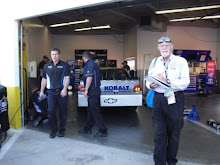Pas de Deux (pronounced as "pah-day-due"), Part 2
Restrictor plates necessitate contact drafting
Engine horsepower is not a single number, but rather a function of speed (engine RPM) and typically has a humped shape; power output increases with engine speed up to a peak and then drops off.
The actual horse power numbers for any given engine and differential gear ratio are a closely guarded secret by each shop. Even though we've seen the actual numbers this is a confidentiality we're not about to breach here so we'll show hp qualitatively (no numbers) but accurately.
A car must be pushed to ram it through the air; the required push (a force) increases proportionally with the square of speed, that is: Force, F = n x (speed x speed).
This diagram shows the pressure on and around a car going 190 mph, high pressure on the front of the car, low pressure behind it.
Those pressures applied over the frontal area of the car determine the aerodynamic drag. (Red is high pressure, blue is low pressure)
It is often informative to also look at the pressures on the surface of the car as well.
The power consumption (force x speed) due to aero drag increases with the cube of speed, that is: (speed x speed x speed), so it increases dramatically with speed, and it just keeps on going up. At 190 mph the force required to ram a NASCAR Cup car through the air is on the order of 700 lbs or more.
The net power (engine less aero drag) describes what is left for accelerating the car.
A plot of the difference between the two curves illustrates the frustration of drivers with restrictor plate racing, when the two curves cross there is zero left to accelerate the car and when the net power gets to zero that's as fast as the car will go.
Note also as the car approaches its terminal speed, the available power for acceleration is also approaching zero, i.e., the car becomes more and more "sluggish," it has no "throttle response," you push the accelerator pedle farther down but the car doesn't go any faster.
The only way to go faster is to reduce aerodynamic drag, hence, the newly realized pas de deux of two cars running nose to tail, literally touching and both cars together ramming the combined block through the air. Notice that the high pressure area on the nose of the second car fills in the low pressure void behind the lead car.
The result is to reduce the overall drag of the two cars together.
Even though the two cars together are not a smooth shape as one can see with the turbulence over the back of the lead car and on the front of the second car, but the combination of two cars pushing together has twice the horse power of one.
Moreover, the two cars have much less drag than the sum of two individual cars, about 27% less drag as shown in these studies.
As a result of the lower aerodynamic drag the speed at which the net power for accelerating the car is zero has increased in the pas de deux, contact drafting. Thus, two cars together go motoring right by a single car or a long string of cars.
While one might think that if two are good, then three should be better, but the dynamics of getting three cars actually touching nose to tail doesn't work. It is physically impossible to keep the front and back contact forces on the middle car centered for any period of time as the cars do bounce around more than a little. Even though the Talladega track is one of the smoothest tracks on the NASCAR circuit, the cars are not on rails and they move relative to each other. As soon as the forces on the middle car are not centered it turns the middle car around. Thus, three cars trying to run as a trio ends up either being two in a pas de deux plus a third as a trailer, or all three do get together and it's called a wreck.
A surprisingly small gap between the cars is sufficient to mitigate the drag reduction compared to two cars in contact with each other. The pas de deux with a trailer just isn't as streamlined as two.
Don't expect to see too much of the pas de deux formation at the Daytona race in July because the Daytona track is much rougher than Talladega so it is much more difficult to keep two cars in actual contact,…but I bet they'll try. With the repaving at Daytona now scheduled to be completed for the 2011 races it may then make DIS the second pas de deux track, sort of a pas de deux of pas de deux racing.
Next week will be the opposite end of the spectrum of tracks, Richmond, where the turns are the tightest (365' radius), except for Martinsville (188' radius), and the banking at 14 degrees is less than half that of Talladega; the race at Richmond is all about brakes and the right gear to accelerate. This is the track where the race car engineers get to show their skills, it's all in the set-up.
Again, these CFD studies in SolidWorks by FastTrack Racing Challenges for participating junior high and high school teams are possible due to the generous support of SolidWorks (visit their web site and look at the full software package at SolidWorks.com) and in particular thanks to Marie Planchard, their director of worldwide education markets.
























